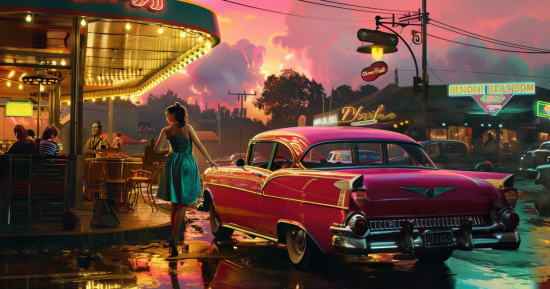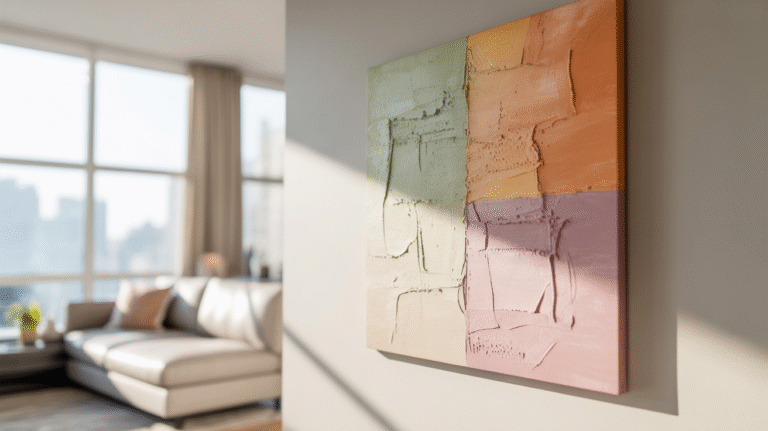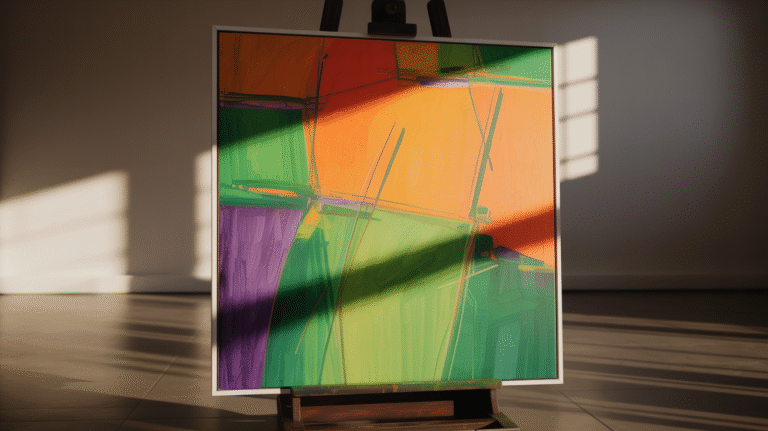The 1950s were a turning point in the art world. Artists began to break the rules, explore bold ideas, and express strong emotions through new techniques. Today, the charm of 1950s style art continues to inspire creators in 2025, thanks to its powerful mix of color, emotion, and cultural commentary.
Let’s dive into the world of retro art and discover what made the 1950s such an exciting time for creativity.
Historical Context of the 1950s Style Art
As you explore the art scene of the ’50s, you’ll notice that this period gave birth to some of the most iconic art movements of the 20th century. Some popular art styles from this era include Abstract Expressionism, which broke the conventional boundaries of art with its focus on emotional expression and bold use of color. Additionally, the Pop Art movement emerged in the late ’50s as a response to consumerism and mass media, bringing everyday objects and popular icons into the fine art world.
The World After War: What Shaped 1950s Art?

In the years after World War II, the world was changing fast. The U.S. became a global leader, and New York City replaced Paris as the heart of the art world. Artists began to express their hopes, fears, and ideas in new, exciting ways.
They used bold brushstrokes, bright colors, and modern materials to reflect the energy of a world that was rebuilding, and dreaming big.
Key Influences:
Global ideas: Artists borrowed techniques and inspiration from cultures around the world.
Post-war emotion: Artists channeled feelings of loss, hope, and transformation.
Consumer culture: Mass media and advertising became everyday life, and art responded.
1950s Art Movements That Changed Everything
The 1950s gave birth to art styles that still shape design and creativity today. Here are the most influential movements from the decade:
🎨 Abstract Expressionism
This movement focused on emotion and energy. Artists painted in bold, free-flowing ways to show how they felt inside.
Key features:
- Big canvases
- Drips, splashes, and sweeping lines
- Emphasis on the artist’s personal feelings
Famous names: Jackson Pollock, Willem de Kooning
🖼️ Pop Art (late 1950s)
Pop Art celebrated (and sometimes mocked) advertising, celebrities, and consumer goods. Everyday objects like soup cans and comic strips became art.
Key features:
- Bright colors
- Simple shapes
- Famous brands and icons
Famous names: Andy Warhol, Roy Lichtensteinand the influences shaping the work of contemporary artists today.
🟣 Color Field Painting
These artists used big blocks of color to create mood and emotion. Instead of bold brushstrokes, they let the colors speak for themselves.
Key features:
- Large areas of soft or solid color
- Calm, emotional feeling
Famous names: Mark Rothko, Barnett Newman
▪️ Minimalism
Minimalist artists removed everything they didn’t need. They focused on basic shapes, soft tones, and quiet feelings.
Key features:
- Clean lines
- Simple forms
- Very few colors
Famous names: Agnes Martin, Donald Judd
Key Movements and Styles

1950s Artists Who Still Inspire Us Today
Jackson Pollock
Jackson Pollock redefined what painting could be. Instead of using traditional tools and techniques, he created art through motion—dripping, splashing, and pouring paint directly onto the canvas. His large-scale “action paintings” captured raw emotion and energy, making the process of painting just as important as the finished piece. Pollock’s fearless style broke artistic conventions and continues to influence modern artists who want to express feeling through movement and spontaneity.
Andy Warhol
Before becoming one of the most recognized figures in Pop Art, Andy Warhol worked in commercial illustration. In the 1950s, he began blending fine art and popular culture in subtle ways. His early experiments with blotted line drawings and hand-colored prints laid the foundation for the bold, iconic imagery he later became famous for. Warhol’s embrace of consumerism and celebrity paved the way for today’s art-meets-media culture, proving that art doesn’t have to be distant or exclusive.
Mark Rothko
Mark Rothko’s paintings are more than just color—they’re emotional experiences. Known for his glowing fields of color that seem to pulse on the canvas, Rothko sought to connect deeply with viewers. He believed that art should express universal human emotions like tragedy, ecstasy, and doom. His 1950s works invite the viewer to slow down, absorb the atmosphere, and reflect. Rothko’s influence can be seen in everything from color theory in design to emotional storytelling in contemporary painting.
The 1950s art world was brimming with groundbreaking artists who pushed the boundaries of their respective styles. By challenging traditional norms and embracing new techniques, these artists paved the way for future generations and left an indelible mark on the history of art.
Popular Techniques from the 1950s

Action Painting
This technique became popular through artists like Jackson Pollock and Willem de Kooning. Action painting involves applying paint in dynamic, spontaneous ways—often without even touching the canvas with a brush. Artists poured, dripped, or flung paint in movements that reflected their emotions in the moment. This approach brought physicality and drama to the creative process, emphasizing the act of painting as a form of performance. The result was bold, unpredictable, and full of energy.
Silkscreen Printing
Silkscreen, or screen printing, allowed artists to reproduce images quickly and cleanly. This method became especially popular with the rise of Pop Art. Artists used stencils and mesh screens to transfer ink onto surfaces like paper or canvas. Andy Warhol used silkscreen to repeat images of celebrities and consumer goods, creating a sense of mass production that mirrored the culture he was critiquing. Today, silkscreen remains a favorite in graphic design and modern printmaking.
Use of Color
Color in 1950s art wasn’t just for decoration—it had a purpose. Abstract Expressionists used dramatic color contrasts to express emotion, while Color Field painters used soft gradients to evoke calm or introspection. Pop Artists leaned into bright, candy-like palettes inspired by advertisements and product packaging. Each movement had its own approach, but all recognized the power of color to make viewers feel something. The bold color choices of this era continue to influence art, fashion, and interior design today.
Experimenting with various color combinations was essential for artists during the 1950s, allowing you to create visually striking and memorable pieces that embodied the spirit of the era. Incorporating these techniques and materials into your own artistic practice can help you connect with the legacy of 1950s art style, and perhaps even inspire new creative avenues for your work.
The Lasting Impact of 1950s Art

Influence on Later Generations
The 1950s style art had a profound impact on later generations of artists. Key movements from this era, such as Abstract Expressionism and Pop Art, significantly shaped contemporary art. Main features of this era include:
- Bold colors and expressive brushstrokes: Many Abstract Expressionist artists utilized bold, highly saturated colors to convey emotions. These visual elements have been present in multiple art styles since the 1950s.
- Integration of popular culture: In the 1950s, artists like Eduardo Paolozzi started incorporating popular culture into their artworks, which led to the development of the Pop Art movement. This approach continues to influence today’s artists who often engage with contemporary media and social issues.
- Exploration of non-traditional materials: Artists like Robert Rauschenberg experimented with new materials during the 1950s, which broadened the range of expressions and styles in art. This spirit of experimentation persists.
Where to See 1950s Art Today
Thanks to the awareness of the importance of 1950s art, numerous institutions and private collectors have focused on preserving and showcasing these influential pieces. Here are a few notable collections:
- Museum of Modern Art (MoMA), New York: MoMA houses an outstanding collection of 1950s art, including seminal works by artists such as Jackson Pollock and Willem de Kooning.
- Tate Modern, London: This museum boasts a strong collection of British and American art from the 1950s, with a focus on both Abstract Expressionism and the early stages of Pop Art.
- Royal Academy of Arts, London: The Royal Academy has hosted several exhibitions celebrating the impact of 1950s art, such as “Abstract Expressionism” and “Eduardo Paolozzi.”
As you explore the legacy of 1950s art, consider visiting these institutions to witness the power and influence of these groundbreaking styles in person.
Do you like the 1950s style art? Feel free to leave us a comment.
FAQ: 1950s Style Art
What is 1950s style art?
It includes art from the post-war era that uses bold colors, abstract forms, and pop culture imagery. Movements like Abstract Expressionism and Pop Art were born in this time.
What styles were popular in 1950s decor?
Pastels, bold patterns, atomic shapes, and mid-century furniture with clean lines.
Who were the top 1950s artists?
Jackson Pollock, Mark Rothko, Andy Warhol (early career), and Willem de Kooning.
Why is 1950s art still important?
It opened the door for modern and contemporary art, encouraging freedom, emotion, and creativity.
Inspired by 1950s style art? Share your favorite piece or artist in the comments below, or check out our Pop Art article to keep exploring!






